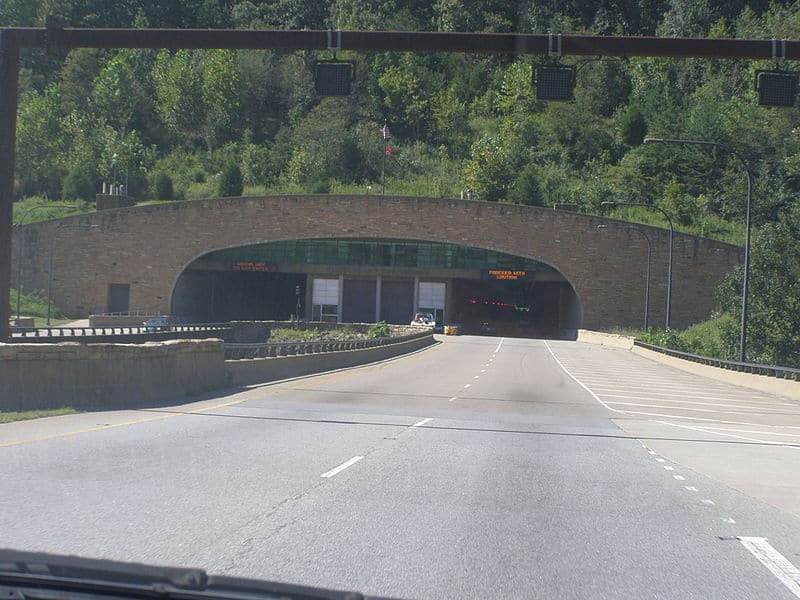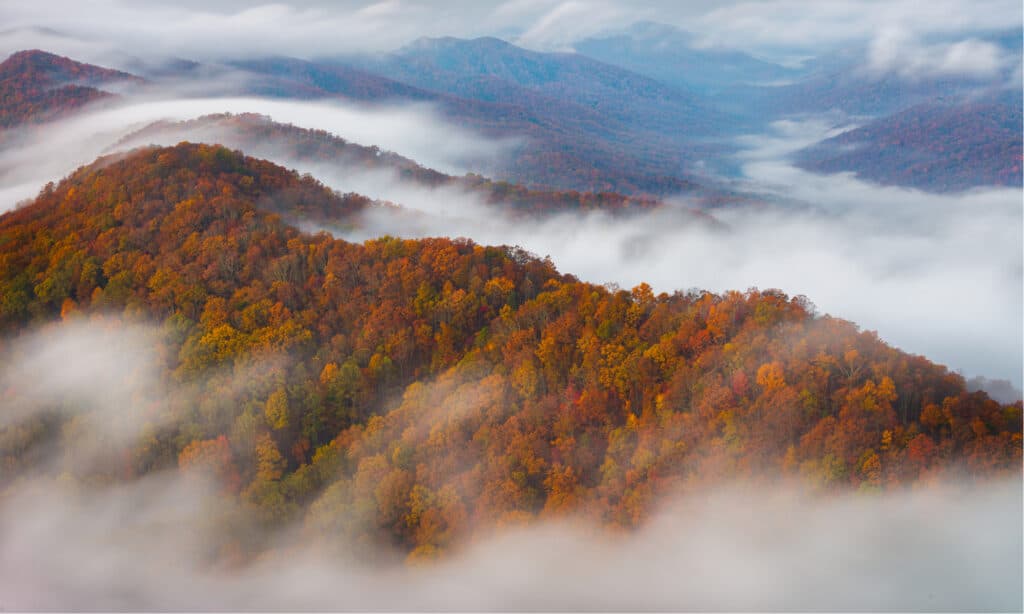Ready to explore a remarkable engineering feat in the Cumberland Mountains? Venture to the Cumberland Gap Tunnel, the longest tunnel in Kentucky. This impressive structure is not your average tunnel. It’s a dual-bore, four-lane marvel that runs beneath the Cumberland Gap National Historical Park. The tunnel is at the junction of Kentucky, Tennessee, and Virginia.
Stretching to a whopping 4,600 feet — nearly a mile — this tunnel started serving traffic back in 1996. It took over from a notorious highway section called ‘Massacre Mountain.’ This road was so dangerous and accident-prone that the tunnel was a welcome relief.
Interesting tidbit: only two vehicular tunnels in the U.S. cross a state line through mountains. One of them is our Cumberland Gap Tunnel. The other is its cousin, the East River Mountain Tunnel, straddling the line between Virginia and West Virginia.

The construction of the Cumberland Gap Tunnel began in 1991.
©Chris Light, CC BY-SA 4.0, via Wikimedia Commons – License
What Is the History Behind the Cumberland Gap Tunnel?
The Cumberland Gap Tunnel began its roots in the 1950s. This is when the National Park Service started exploring the idea of building a tunnel underneath the Cumberland Gap. The Cumberland Gap is a mountain pass that was crucial to American colonial history. This is because it was the site where the first pioneers crossed the Appalachian Mountains into Tennessee.
In 1991, the construction of the Cumberland Gap Tunnel began with blasting the northbound tunnel. This was a crucial and expensive public works project in Kentucky that aimed to replace the dangerous and curvy road through Cumberland Gap. The previous road, which was a two-lane road, carried twice the amount of traffic it could handle. It had an accident rate six times higher than the national average. It was called “Massacre Mountain” due to the high number of accidents on it.
How Did the Cumberland Gap Tunnel Affect Traffic?
The Cumberland Gap Tunnel was finished on July 9, 1992, after 1,947 days of work and for a cost of $280 million. The two sides of the tunnel met in the center with precise alignment. After its completion, the tunnel was officially open for highway traffic on October 18, 1996. It comprises two separate bores, each with two lanes, and stretches for about 4,600 feet (1,300 meters) between Cumberland Gap, Tennessee, and Middlesboro, Kentucky.
The opening of the Cumberland Gap Tunnel forever changed the face of the Cumberland Gap National Historical Park, as it removed traffic from the historic corridor traversed by U.S. Highway 25E for more than 50 years. The restoration of the Cumberland Gap began in 1973 with the signing of a law directing the National Park Service to construct tunnels through Cumberland Mountain. Today, the Cumberland Gap Tunnel is a testament to the engineering and preserving the area’s historical and natural beauty.

What Wildlife Can You Find Around Cumberland Gap Tunnel?
The Cumberland Gap National Historical Park, which surrounds the Cumberland Gap Tunnel, supports various wildlife. Many different types of animals can be seen near the tunnel, including white-tailed deer, black bears, bobcats, gray foxes, rabbits, raccoons, gray squirrels, opossums, striped skunks, bats, songbirds, wild turkeys, hawks, vultures, snakes, and turtles. The park’s diverse habitats and elevation range contribute to the rich animal life in the area. Although it’s easy to spot white-tailed deer and gray squirrels along roadsides and trails, many other species are nocturnal or secretive and harder to find.
The park has over 85 miles of hiking trails, which offer opportunities to discover various habitats and increase your likelihood of spotting wildlife. While observing wildlife, remember to maintain a safe distance and defy venomous snakes and bears properly. The best way to observe wildlife in Cumberland Gap National Historical Park is to visit during the early morning or just before sunset when many animals are most active and visible. The Pinnacle Overlook in the park is an ideal place to view hawks during the fall migration.

You can go on a guided tour at Cumberland Gap National Historical Park; however, they focus mostly on geological and historical features.
©anthony heflin/Shutterstock.com
Are There Any Guided Tours or Programs Available for Wildlife Observation in Cumberland Gap National Historical Park?
Guided tours and programs are available at Cumberland Gap National Historical Park, but they primarily focus on the park’s historical and geological features rather than wildlife observation. Some guided tours offered include Gap Cave Tours and Hensley Settlement Tours. Gap Cave Tours takes visitors on a two-hour adventure exploring the majestic underground cave, where you might glimpse a bat or salamander. Another is the Hensley Settlement Tour which involves a 3.5-hour journey, including a one-mile walk through the settlement.
While these guided tours do not specifically focus on wildlife observation, you can still enjoy self-guided hikes and explore the park’s diverse habitats, which may increase your chances of encountering wildlife. For information about upcoming programs or to make guided tour reservations, call the park at 606-248-2817.
Unique Rock Formations in Cumberland Gap National Historical Park
Cumberland Gap National Historical Park, encompassing the Cumberland Gap Tunnel, exhibits several exceptional rock formations that you may find intriguing:
White Rocks
These massive sandstone formations are famous for being a marker that indicated settlers were one day’s walk from the crossing at Cumberland Gap. The White Rocks are on the ridge of Cumberland Mountain and can be accessed via the Ewing Trail and Ridge Trail.
Newman Limestone
The Newman Formation is a 500-foot-thick layer of limestone in Gap Cave. This is a prominent feature within the park Gap Cave is open for ranger-guided tours from April to the end of September. It offers visitors a chance to explore this unique limestone formation.
Chattanooga Shale
This interesting formation is in the Appalachian region, including areas near the Cumberland Gap. The Chattanooga Shale is known for its unique properties and has been the subject of geological studies.
Mississippian Period Sandstones
These sandstone formations are part of the Mississippian System in Kentucky, which consists of mostly marine sedimentary rocks. The sandstone beds are interpreted as turbidite deposits based on their morphology and internal features.

The Cumberland Gap Tunnel is near some impressive trails.
©Jeffery L Willis/Shutterstock.com
Other Attractions Around the Longest Tunnel in Kentucky
There are several attractions around the Cumberland Gap Tunnel that you may find interesting. Some of the most gorgeous ones are but not limited to:
Tri-State Peak Trail
The first trail is Tri-State Peak. This mountain is located in the Cumberland Gap National Historical Park, near the “saddle” of the gap. The peak gets its name from being on the tri-point of Kentucky, Tennessee, and Virginia.
Bell County Historical Society
This organization preserves the history of Bell County, Kentucky. It also operates a museum that showcases local artifacts and historical exhibits.
Pinnacle Overlook
The Pinnacle Overlook in Cumberland Gap National Historical Park provides breathtaking panoramic views of nearby mountains and valleys. It’s also a great spot to see hawks’ fall migration.
Little Congress Bicycle Museum
This unique museum is located in the historic town of Cumberland Gap and features a collection of antique bicycles and memorabilia related to the history of cycling.
Where is Cumberland Gap Tunnel Located on a Map?
The Cumberland Gap Tunnel is a vehicular tunnel with dual bores and four lanes. It facilitates U.S. Route 25E passage beneath Cumberland Gap National Historical Park, it is found near the intersection point of Kentucky, Tennessee, and Virginia.
Here is Cumberland Gap Tunnel on a map:
Conclusion
The Cumberland Gap Tunnel is a fascinating engineering feat and offers visitors the chance to explore the history of this region. Many individuals from various locations journey to witness the beauty of this place every year, as it possesses remarkable geological characteristics, numerous attractions, and great historical significance. Whether you’re looking for a great view or want to learn more about the area’s cultural heritage, there’s something for everyone at the Cumberland Gap Tunnel. Enjoy your visit!
The photo featured at the top of this post is © Chris Light, CC BY-SA 4.0, via Wikimedia Commons – License / Original
Thank you for reading! Have some feedback for us? Contact the AZ Animals editorial team.







